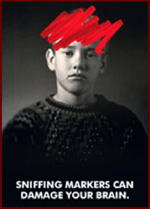
Most inhalants are common household products. They include paint thinner, fingernail polish remover, glue, gasoline, cigarette lighter fluid, and nitrous oxide. They also include fluorinated hydrocarbons that are found in aerosols, such as whipped cream, hairspray, spray paint, and computer cleaners. Used as intended, these household products are safe. When these products are sniffed, however, their toxic fumes can produce mind-altering effects.
Inhalants are often among the first drugs that young children use. One national survey conducted in 2003-2004 found that 2.5 percent of 4th-graders had used inhalants at least once in the year prior to being surveyed. Inhalants also are one of the few substances that younger children abuse more than older ones do. Yet, inhalant abuse can become chronic and extend into adulthood.
Data from national and State surveys suggest that inhalant abuse is most common among 7th- through 9th-graders. For example, in the Monitoring the Future study, an annual NIDA-supported survey of the Nation's secondary school students, 8th-graders regularly report the highest rate of current, past-year, and lifetime inhalant abuse; 10th- and 12th-graders report less abuse of inhalants.
Many kids think inhalants are a harmless, cheap, and quick way to "catch a buzz." The chemicals in the vapors change the way the brain works, making the user feel very good for a short time. Inhalants can be found around the house or purchased inexpensively at the local grocery or general store. What kids often don't know is that, in some cases, the harmful effects of inhalants can be irreversible.
When inhaled through the nose or mouth, most inhalants produce a rapid high that resembles alcohol intoxication. Individuals first feel excited, then drowsy, uninhibited, lightheaded, and agitated. If sufficient amounts are inhaled, nearly all solvents and gases produce anesthesia (loss of sensation) and even unconsciousness.
Because the intoxication generally lasts only a few minutes or, at most, several hours, abusers often try to prolong the high by repeatedly inhaling the substance over several hours. With successive inhalations, users can suffer loss of consciousness or death.
Regular abuse of inhalants can result in serious harm to vital organs in the body, including the brain, heart, kidneys, and liver. The vaporous fumes can change brain chemistry and may permanently damage the brain and central nervous system. They can cause abnormalities in brain areas that are involved in movement and high cognitive function. Frequent, long-term use can cause a permanent change or malfunction of nerves, called polyneuropathy. Certain inhalants can also cause the body to produce fewer of all types of blood cells, which may result in a disorder called aplastic anemia.
Other symptoms seen by long-term inhalant abusers include weight loss, muscle weakness, disorientation, inattentiveness, uncoordinated movement, irritability, and depression.
Prolonged sniffing of the highly concentrated chemicals in solvents or aerosol sprays can induce irregular or rapid heart rhythms and lead to heart failure and death within minutes of a session of prolonged sniffing. This "sudden sniffing death" can result from a single session of inhalant use by an otherwise healthy young person.
Some individuals, particularly those who abuse inhalants heavily and for a long time, report a strong need to continue using inhalants. Compulsive use and a mild withdrawal syndrome can occur with long-term inhalant abuse.
Parents, friends, and teachers should be aware of the following signs of inhalant use:
When someone has a drug problem, it's not always easy to know what to do. If someone you know is using inhalants, encourage him or her to talk to a parent, school guidance counselor, or other trusted adult. In addition, the Substance Abuse and Mental Health Services Administration's Center for Substance Abuse Treatment (CSAT) has a National Drug and Alcohol Treatment Service that provides free and confidential information on hotlines and counseling services. CSAT's toll-free phone number is 1-800-662-4357; treatment centers by state can also be located at www.findtreatment.samhsa.gov.
[Back to top]